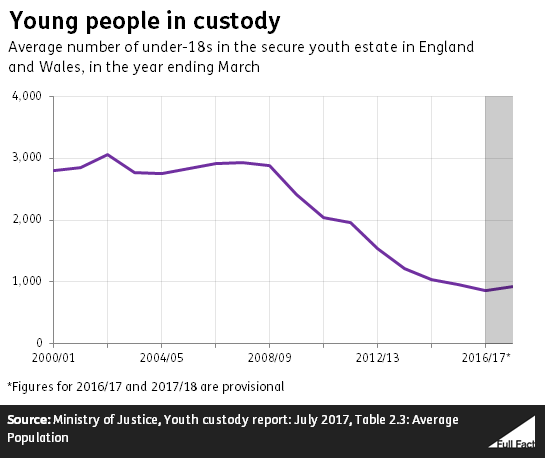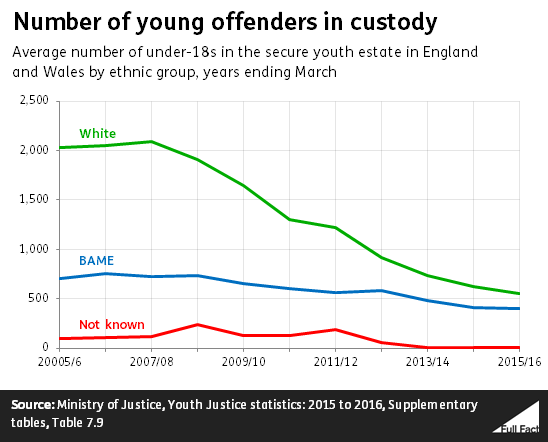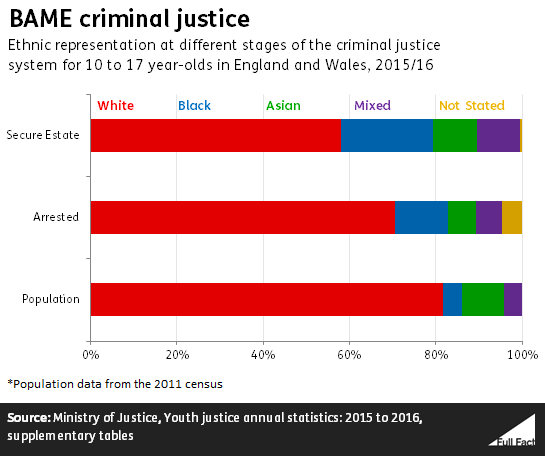What was claimed
The proportion of BAME young offenders in custody rose from 25% to 41% between 2006 and 2016.
Our verdict
Correct for England and Wales.
What was claimed
The proportion of BAME young offenders in custody rose from 25% to 41% between 2006 and 2016.
Our verdict
Correct for England and Wales.
What was claimed
The number of young offenders has fallen to a record low.
Our verdict
That’s correct for England and Wales.
“Despite the overall number of young offenders falling to record lows, the proportion of BAME young offenders in custody rose from 25% to 41% between 2006 and 2016.”
Huff Post, 8 September 2017
A number of newspapers picked up on this finding from the recent review into the treatment of BAME people in the criminal justice system by Labour MP David Lammy.
It’s correct that the number of young offenders in England and Wales is at a record low, as is the number of young offenders detained in the “secure youth estate”. This includes young offender institutions, secure children’s homes and secure training centres.
It’s also correct that there is an increasing proportion of BAME young offenders in the secure estate. The number of Black, Asian and minority ethnic (BAME) young offenders in the secure youth estate is decreasing, but not as quickly as the number of white young offenders.
Join 72,547 people who trust us to check the facts
Subscribe to get weekly updates on politics, immigration, health and more.
The number of young people given any type of sentence in court has been falling. It was just under 97,000 in 2005/06 compared to fewer than 28,000 in 2015/16.
Only about 6% are given a custodial sentence in any given year.
The number of young offenders sentenced to custody in the “secure youth estate” has also been falling.
On average there were 959 under 18s in the secure youth estate in any given month in 2015/16, down from 2,832 across 2005/06. Provisional figures suggest that it continued to decrease in 2016/17, and then will increase slightly to 921 in 2017/18.
We’re looking into the reasons behind this fall in numbers. The Lammy Review says that Youth Offending Teams have been largely successful in reducing youth offending and reoffending.
In 2015/16 the most common primary offences of young people in custody were ‘violence against the person’ (34% of young offenders in custody) and robbery (25%).

Despite the overall fall, the numbers being held in custody for some types of offences is increasing; namely drug offences and sexual and violent offences.
It’s correct that the proportion of young BAME offenders in the secure youth estate is increasing. It went from 25% of the population in custody in 2005/06 to 41% in 2015/16.

That doesn’t mean the number of BAME young offenders in custody has increased – over the ten years it went from 701 down to 398. But the number of BAME young offenders in the secure youth estate hasn’t decreased as quickly as the number of young white offenders has.

The review by David Lammy concluded that there was no single reason for the overrepresentation of people from BAME backgrounds (both young and old) in the criminal justice system.
It said that BAME people were more likely to be arrested, but that this didn’t fully explain their over-representation in the secure estate. They were also more likely to plead not guilty in court (the review found that when someone pleaded guilty they were more likely to receive a shorter sentence or a community sentence).
The review also looked into the severity of sentences given to BAME people. It found that they were more likely than white defendants to receive a prison sentence for drug offences at the Crown Court in 2015, even once past convictions were taken into account. But it wasn’t able to find an “evidence-based explanation” for this happening.
We’ve looked more into this here.
The proportion of young BAME people varies at different points in the criminal justice system.
Roughly 18% of 10 to 17 year olds identified as BAME at the time of the 2011 census. In comparison 25% of 10 to 17 year olds arrested for a crime in 2015/16 were BAME and 41% of those in the secure youth estate.

Full Fact fights for good, reliable information in the media, online, and in politics.
Bad information ruins lives. It promotes hate, damages people’s health, and hurts democracy. You deserve better.